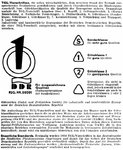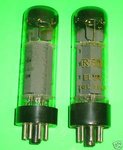Unfortunately (or fortunately) it's not that simple, to judge about RFT's
First you have to differ between 60's production, 70's production and 80's production (production has ended in spring 1989)!
Second you must know, that 60's production is superior to 70's production, but 70's production is superior to 80's production!
But how to differ?
50's and 60's RFT's do have a pretty flat tube's base.
70's RFT's have printed additional to the 6-digit production code "TGL9649" and most of them additional do have a triangle printed on, where inside is either a "S" or a "1" or a "2" or it's empty.
- S is the best choice and means "Sonderklasse" - translated ~about~ best selection
- 1 means, that the tube was tested and is of an excellent quality, most of them went into export
- 2 means, that the tube was tested, but parameters weren't absolutely convincingly. These tubes went uinto the national supply.
- empty means, this tube wasn't tested for purpose, but has easily withstand a quick test.
I've attached a sheet, but describtion is in German

80's RFT's only wear the RFT logo and a 6-didgit production code - nothing else.
But keep in mind, that many of the 'Siemens' or some misspell it 'Seimens' labelled RFT tubes went over the pond in the early 90's and are from late 80's production. Often you can't verify this, because the tubes became relabelled 'Ultron' or 'RCA' or 'Mesa/Boogie' or, or, or.....
... but then watch the tube's top! Is there a smooth dimple, then it's presumably from the 70's or from the very early 80's
is there a not so nice spot, what rather looks like a welding spot from automotive production, then it's presumably mid to late 80's
Ok, this was the lesson of today

But now to my (over 20 years) experience with RFT's:
I've never had failing a 60's RFT in any amp. They all were strong, constant and have had a remarkable life span.
With only a hand ful exceptions the same is valid for all the 70's RFT's, which already went through my hands.
I've built 70's RFT's into earl 70's Marshall Super Lead's with a B+ of 530V (!) w/o any problems!
I've built in 70's RFT's in Marshalls of customers with 150+ gigs every year - and after 3 years the tubes still were working well.
But I've had troubles and headache with 80's RFT's, especially with mid to late 80's and especially in amps with a B+ close to 500V or beyond.
But in amps with a B+ up to 470V they're nonetheless working fine.
And there's only one EL34 type, what IMO nails the RFT soundwise, in reliability and longevity - it's the 'real' Mullard,
NOT made in Russia!
Larry
BTW: The output tubes I'm using in my DINO amps and what I will be using also in my forthcoming 'Jon Schaffer Signature Head' are RFT EL34's from 73's production - standard, no extra charge.



